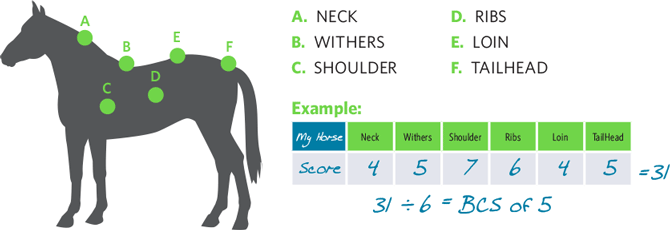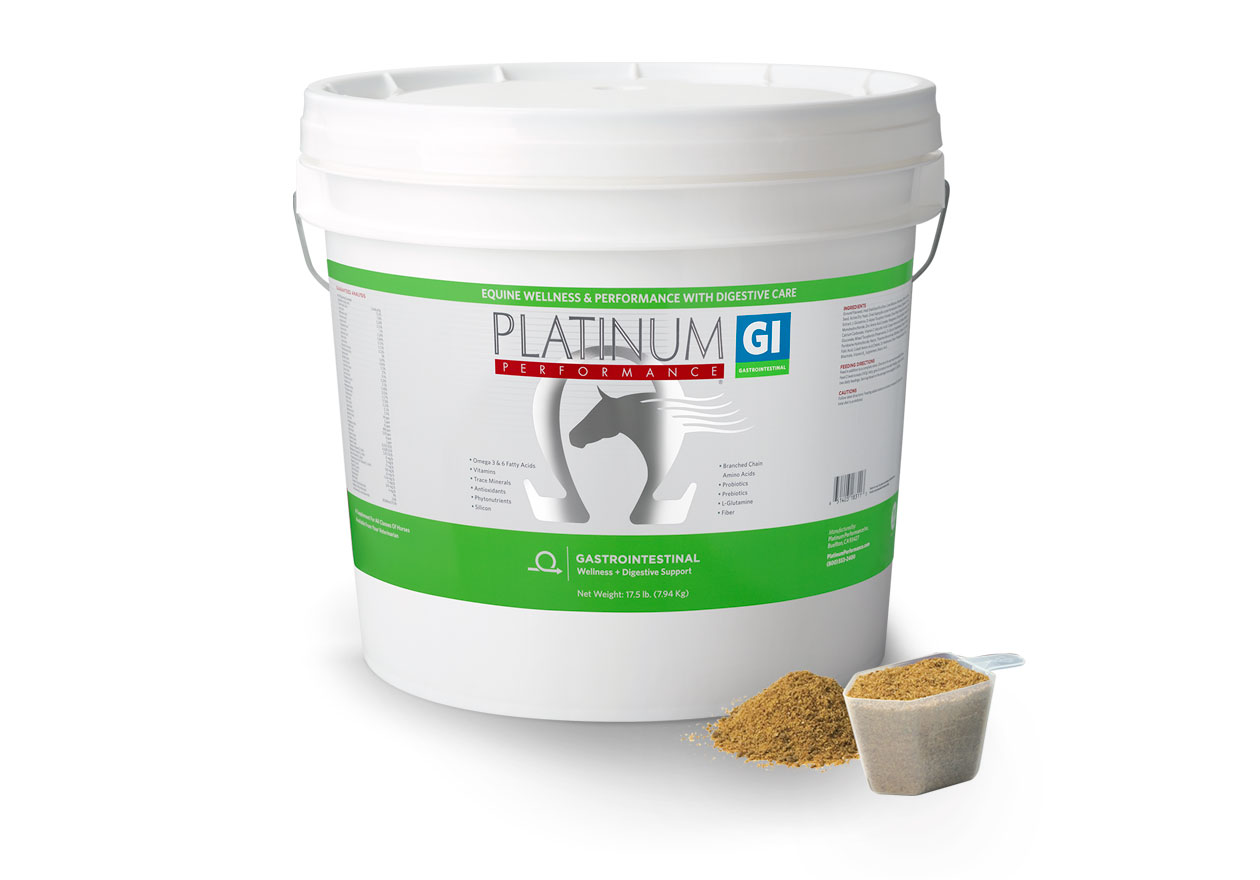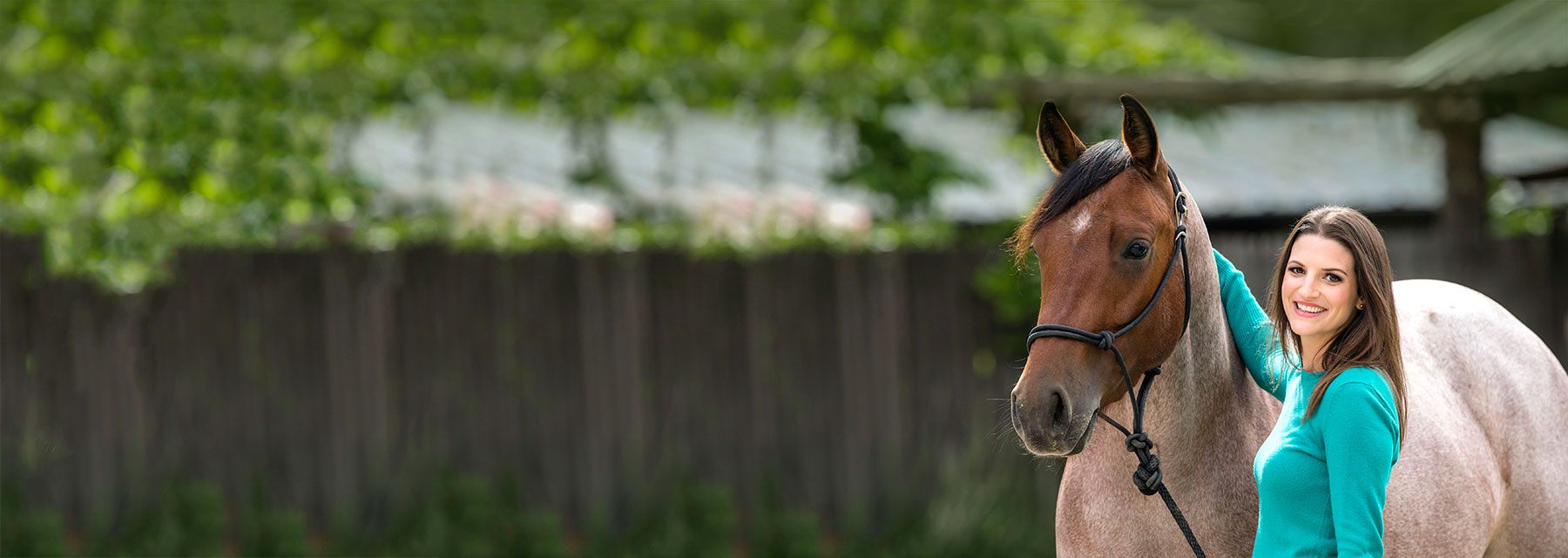The Body Condition Score (BCS) can be a useful tool for developing diets appropriate for maintaining the health and longevity of an individual horse.
How to Score Your Horse
Follow these 3 simple steps. Using the Body Condition Score Chart give a score of 1 to 9 to each of the 6 points of reference. Next add these 6 scores together. Then divide by 6. This is your horse’s Body Condition Score. See Equine Body Conditions

| Score | Neck | Withers | Shoulder | Ribs | Loin | Tailhead |
| 1 | Bone structure easily noticeable | Bone structure easily noticeable | Bone structure easily noticeable | Ribs protruding prominently | Spinous processes projecting prominently | Tailhead, pinbones, and hook bones projecting prominently |
| 2 | Bone structure faintly discernible | Bone structure faintly discernible | Bone structure faintly discernible | Ribs prominent | Spinous processes are prominent with some fat covering over their base. Transverse processes of lumbar vertebrae feel rounded. | Tailhead prominent |
| 3 | Neck accentuated | Withers accentuated | Shoulder accentuated | Slight fat over ribs. Ribs easily discernible | Fat buildup halfway on spinous processes, but easily discernible. Traverse processes cannot be felt. | Tailhead prominent but individual vertebrae cannot be visually identified. Hook bones appear rounded, but are still easily discernible. Pin bones not distinguishable. |
| 4 | Neck not obviously thin | Withers not obviously thin | Shoulder not obviously thin | Faint outline of ribs discernible | Negative crease (peaked appearance) along back | Prominence depends on conformation. Fat can be felt. Hook bones not discernible |
| 5 | Neck blends smoothly into body | Withers rounded over spinous processes | Shoulder blends smoothly into body | Ribs can be easily felt, but cannot be visually distinguished. | Back is level | Fat around tailhead beginning to feel soft |
| 6 | Fat beginning to be deposited | Fat beginning to be deposited | Fat beginning to be deposited | Fat over ribs, feels spongy | May have a slight positive crease (a groove) down back | Fat around tailhead feels soft |
| 7 | Fat deposited along neck | Fat deposited along withers | Fat deposited behind shoulder | Can feel ribs with pressure, but noticeable fat filling between ribs | May have a positive crease down the back | Fat around tailhead is soft |
| 8 | Noticeable thickening of neck | Area along withers filled with fat | Area behind shoulder filled in flush with body | Difficult to feel ribs | Positive crease down the back | Fat around tailhead very soft |
| 9 | Bulging fat | Bulging fat | Bulging fat | Patchy fat appearing over ribs | Obvious crease down the back | Bulging fat around tailhead |
Equine Body Conditions
Too Thin

1 - POOR
Extremely emaciated. Backbone, ribs, tailhead, hip joints, and lower pelvic bones project prominently; bone in withers, shoulders and neck are easily noticed. No fatty tissue can be felt.

2 - VERY THIN
Emaciated. Slight fat covers vertebrae. Ribs, tailhead, hip joints and lower pelvic bones are prominent. Withers, shoulders and neck structure faintly discernable.

3 - THIN
Fat buildup about halfway on backbone. Slight fat covers ribs that are easily discernible. Tailhead prominent but individual vertebrae cannot be identified visually. Hip joints appear rounded but easily discernable. Withers, shoulders and neck accentuated.

4 - MODERATELY THIN
Slight ridge along back. Faint outline of ribs discernable. Tailhead prominence depends on conformation, but fat can be felt around it. Hip joints not discernable. Withers, shoulders and neck not obviously thin.
Ideal

5 - MODERATE
Back is flat; ribs easily felt, but not visually distinguishable. Fat around tailhead feels a bit spongy. Withers round over spinous processes; shoulders and neck blend smoothly into body.
Obese

6 - MODERATELY FLESHY
May have slight crease down back. Fat over ribs spongy; fat around tailhead soft. Small fat deposits behind shoulders and along sides of neck and withers.

7 - FLESHY
Might have slight crease down back. Individual ribs can be felt, but noticeable filling between ribs with fat. Fat around tailhead soft; fat deposited along withers, behind shoulders and along neck.

8 - FAT
Crease down back. Difficult to feel ribs. Fat around tailhead very soft; area along withers filled with fat. Area behind shoulder filled with fat, noticeable thickening of neck. Fat deposited along inner thighs.

9 - EXTREMELY FAT
Obvious crease down back. Patchy fat appears over ribs. Bulging fat around tailhead, along withers, behind shoulders and along neck. Fat along inner thighs may rub together. Flank filled with fat.
Tips for Increasing Body Condition Score
Horses are generally considered to be underweight with a BCS ≤ 3. Being underweight may affect overall health and athletic performance. Horses that are extremely underweight with a BCS of 1 or 2 may have suppressed immunity and are at higher risk for contracting disease.
- Weight gain is a slow process. For an average 1000 lb horse, a single body condition increase may be approximately 40-50 lbs of body weight and take 60 days or more to increase depending on consistency of calories fed above maintenance.
- Maximize forage. Early maturity hay with a high leaf-to-stem ratio can promote weight gain. Increasing the intake of good quality hay is preferred over adding carbohydrate-based grains and concentrates. Providing free choice access to good quality hay is the cornerstone for healthy weight gain.
- Adding alfalfa, either as loose hay, cubes or pellets can be beneficial in adding weight.
- Using a “Super Fiber” such as beet pulp is a healthy way to add calories. Beet pulp contains high levels of digestible fiber and offers more calories per pound than hay.
- Fats such as oil contain a more concentrated way to provide calories in the diet. Flaxseed oil, such as Platinum Healthy Weight, is rich in omega-3 fatty acids and is an excellent source of anti-inflammatory calories and antioxidants.
- Pre- and probiotics are an extremely useful tool for digestive health as they nurture the beneficial microflora in the gastrointestinal tract. Platinum Performance® GI increases feed efficiency and improves nutrient utilization.
- Weight: An equine scale is best for measuring equine weight. However, a simple weight tape can also give a good estimate of the horse’s weight. Taking pictures of the horse in the same background can also be a good visual of progress. Try taking pictures from different angles such as from the front, from behind and a side angle. As it is a slow process, re-assess weight every 3-4 weeks to monitor progress.
* Horses should be evaluated by a veterinarian for any underlying causes of being underweight that may include digestive problems, poor dental condition, old age and parasitism.
Tips for Decreasing Body Condition Score
A BCS of 7 is considered overweight, and BCS > 8 is obese. Being overweight may contribute to metabolic issues such as insulin resistance and laminitis. Obesity may be associated with reproductive dysfunction in mares.
- Most cases of overweight horses are contributed to overfeeding, a lack of exercise or both. Genetics play a role in some cases as well. It is important that the owner or caregiver recognizes that the horse requires weight loss for optimal health.
- Horses require no less than 1% of their body weight in forage daily for normal gastrointestinal motility, to minimize the risk of gastric ulceration and prevent stereotypies, such as cribbing and weaving. Under no circumstances should the horse be “starved” to facilitate weight loss.
- Later maturity hays with a lower energy content may be used to provide needed fiber with less calorie content. Analyzing the hay may be useful. Platinum Performance® Equine should be added to the diet to provide necessary vitamins, minerals, antioxidants and omega-3 fatty acids that a more mature hay may be lacking.
- Horses that need to lose weight should still have access to forage throughout the day. A grazing muzzle for horses on pasture may be a helpful tool. A slow feeder for hay can slow the eating process and still allow a slow fiber trickle to ensure digestive well-being.
- Eliminating grains, concentrates and other calorie-dense feeds is recommended.
- Increasing exercise when possible can be very beneficial for weight loss as well as to increase insulin sensitivity.
- Losing weight in a healthy way is a slow process. Evaluating weight loss at the same time each month with a scale or weight tape is a good gauge to monitor process.
All feeding changes should be made gradually over 7-10 days to avoid gastrointestinal upset. This is true whether feeds are being added, taken out of the diet, or changing types (including hay).
* Horses should be evaluated by a veterinarian for causes of high body condition and obesity to correctly assess the best dietary changes.

Equine Wellness & Performance Formula + Digestive Care
The health of the equine gut is important for proper digestion, but it is also correlated with immunity, metabolism, gastrointestinal function and more.
Learn More
